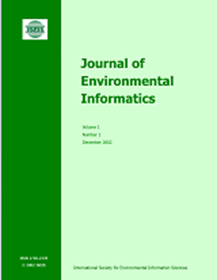景观格局对河流水质的时空影响:多尺度地理加权回归方法
IF 5.4
1区 环境科学与生态学
Q1 ENVIRONMENTAL SCIENCES
引用次数: 0
摘要
河流的水质可以被认为是其周围景观的一个功能。了解景观格局与河流水质之间的关系是优化景观格局以减少流域污染的关键,但这一问题尚未得到解决。采用多尺度地理加权回归(MGWR)模型探讨了景观格局与水质之间的关系。结果表明,不同季节景观指标与水质的关系在不同空间尺度上存在差异。NO3——N、NH4+-N和TN的最大独立影响变量分别是茶园、住宅用地和不同季节。在流域尺度上,景观指标对总磷的影响在全年内相对较弱。景观指标对NO3——N的影响在汛期更为显著,而对NH4+-N的影响在非汛期更为显著。影响全氮景观指标的季节变化不规律。虽然景观组成对水质的影响大于配置,但Shannon多样性指数和斑块密度是显著影响水质的重要配置指标。因此,在土地资源有限的情况下,在不改变流域构成的前提下,优化景观空间配置,降低河流污染风险至关重要。研究进一步表明,MGWR模型可以很好地量化流域尺度上景观格局对水质的影响。本文章由计算机程序翻译,如有差异,请以英文原文为准。
How Landscape Patterns Affect River Water Quality Spatially and Temporally: A Multiscale Geographically Weighted Regression Approach
The water quality of a river can be considered a function of its surrounding landscape. Understanding the relationship between landscape patterns and river water quality is essential for optimizing landscape patterns to reduce watershed pollution and has not yet been solved. A multiscale geographically weighted regression (MGWR) model was used to explore the associations between the landscape patterns and water quality. Our results showed that landscape metrics have varied relationships with the water quality across spatial scales in different seasons. The strongest independent influencing variable for NO3–-N, NH4+-N, and TN was tea gardens, residential land, and varied seasonally, respectively. The impacts of the landscape metrics on the TP were relatively weak throughout the year at the watershed scale. The influence of landscape metrics on NO3–-N was more significant during the flood season, whereas that on NH4+-N was more notable during the non-flood season. Seasonal changes in the influencing landscape metrics of TN were not regular. Although landscape composition more significantly influenced water quality than configuration, the Shannon’s diversity index and patch density were important configuration indices that significantly impacted water quality. Therefore, with limited land availability, it is essential to optimize the landscape spatial configuration without changing the composition of the watershed to reduce the risk of river pollution. This study further indicated that the MGWR model can well quantify the effects of landscape pattern on water quality at the watershed scale.
求助全文
通过发布文献求助,成功后即可免费获取论文全文。
去求助
来源期刊

Journal of Environmental Informatics
ENVIRONMENTAL SCIENCES-
CiteScore
12.40
自引率
2.90%
发文量
7
审稿时长
24 months
期刊介绍:
Journal of Environmental Informatics (JEI) is an international, peer-reviewed, and interdisciplinary publication designed to foster research innovation and discovery on basic science and information technology for addressing various environmental problems. The journal aims to motivate and enhance the integration of science and technology to help develop sustainable solutions that are consensus-oriented, risk-informed, scientifically-based and cost-effective. JEI serves researchers, educators and practitioners who are interested in theoretical and/or applied aspects of environmental science, regardless of disciplinary boundaries. The topics addressed by the journal include:
- Planning of energy, environmental and ecological management systems
- Simulation, optimization and Environmental decision support
- Environmental geomatics - GIS, RS and other spatial information technologies
- Informatics for environmental chemistry and biochemistry
- Environmental applications of functional materials
- Environmental phenomena at atomic, molecular and macromolecular scales
- Modeling of chemical, biological and environmental processes
- Modeling of biotechnological systems for enhanced pollution mitigation
- Computer graphics and visualization for environmental decision support
- Artificial intelligence and expert systems for environmental applications
- Environmental statistics and risk analysis
- Climate modeling, downscaling, impact assessment, and adaptation planning
- Other areas of environmental systems science and information technology.
 求助内容:
求助内容: 应助结果提醒方式:
应助结果提醒方式:


